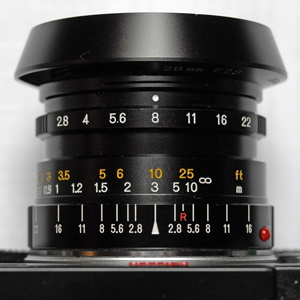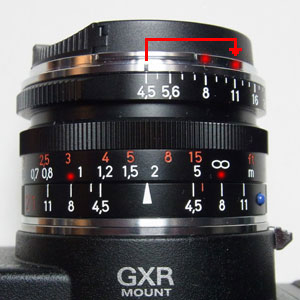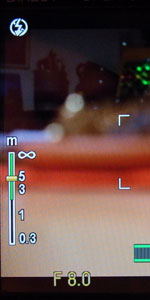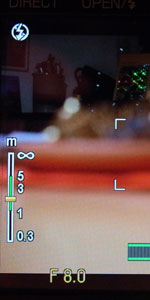Hyperfocal Autofocus
On this page, I present an "invention" that I made recently: the hyperfocal autofocus (HFAF). I am convinced that someone else already invented this focus mode - but now I re-invented it on my own. And so far - as far as I know - no digital camera offers it...
In Short
My proposal is to take the parameters used to calculate the hyperfocal distance (aperture, focal, length, and circle of confusion(coc)) and make the camera set the hyperfocal distance automatically. The camera knows them all, focal length and coc anyway, and aperture for some exposure modes in advance (A, M= > aperture is set by the user), for others after measuring exposure (P, S => aperture is set by the camera).
Thus, the camera would just do what we would do manually when we set the hyperfocal distance, which is easy for manual lenses, but hard for some automatic lenses. In both cases, you have to remember the settings (or write them on a sheet of paper)...
I think that my proposal is rather simple and could be easily implemented. It might even be possible to set the far limit below infinity - just a few more simple calculations. This additional feature might be useful for street and indoor photographers.
Prelude
When you set a lens to the hyperfocal distance, everything will be sharp from half the hyperfocal distance to infinity. This is useful when shooting landscape snapshots with manual focus and aperture, but it may also be useful for other photographic genres. The hyperfocal distance is most useful for wide lenses with a large depth of field.
Elsewhere, I provide detailed information about how to calculate the hyperfocal distance, but for the moment, we need only to know that it can be calculated and that it depends on three factors:
- Focal length (the exact length, not the equivalent length)
- Aperture (f-number)
- Circle of confusion (coc) => defines technically the "sharpness" of an image
On a camera with a manual focus ring and a distance scale, setting the hyperfocal distance is easy (see Figures 1 and 2): You choose an aperture (f/8 in Figure 1, f/11 in figure 2, but you have to consider the f/8 distance marks) and move the focus ring so that the center of the infinity mark meets the respective right aperture mark. The resulting distance value (at the central mark for the distance) is the hyperfocal distance, and the aperture marker on the left indicates the minimum distance from which the image is sharp (as defined by the coc that is "inbuilt" into the focus ring). This "minimum" distance should be half the hyperfocal distance.
 |
 |
 |
Figures 1-3: Hyperfocal distance demonstrated with a manual lens at a full-frame camera (at f/8, the hyperfocal distance is about 3 m, the sharpness zone ranges from about 1.5m to infinity; left) a different manual lens at an APS-C body (at f/11, you need to consider f/8; therefore, the hyperfocal distance is about 1.8 m, the sharpness zone ranges from about 0.95 m to infinity; center*), and with an AF lens (at f/8, the hyperfocal distance is about 4.5 m, the sharpness zone ranges from about 2 m to infinity; right); the latter lens is probably not set optimally.
*) Since this is a full frame lens on an APS-C body, the depth of field range actually has to be considered for an aperture of about f/8, when f/11 is set. Note that currently f/4.5 is set at the lens!
On an automatic camera, you typically set the focus manually using some buttons and dials. This can be a cumbersome procedure - as is the case for the Ricoh GXR and GR. If the camera displays a depth of field scale on the LCD monitor or viewfinder, you may try to simulate the manual procedure by observing the DOF markers. This is possible on the Ricoh cameras, but it is cumbersome (see Figure 3).
You can also retrieve the respective value for a given aperture and focal length from a sheet of paper that you carry with you. Often, however, the scale is not detailed enough for setting the distance accurately (see Figure 2). Nevertheless, on this site, I offer hyperfocal distance tables for the Leica X Vario (which has a manual focus ring but lacks aperture marks, because it has a zoom lens) and for the Ricoh GR (which lacks a manual focus ring) that you can print for this purpose.
The Ricoh cameras offer a "snap focus" mode, which makes it easy to set the camera to a fixed distance (if offers a certain range of values, for example, 1 m, 1.5 m, 2 m, 2.5 m, 5 m and infinity for the GR). This mode can aid in using hyperfocal distances, but the "snap distances" may not exactly correspond to them (look here for some recommendations for the Ricoh GR).
The Idea: Hyperfocal AF (HFAF) for Automatic Cameras
Autofocus cameras set the distance based on some measurements of the scene that the camera is intended to take a photo of. Usually, there are several modes available (multi-AF, spot-AF, pinpoint-AF, face detection, and more), each having its uses, advantages, and disadvantages that I do not want to discuss here.
Hyperfocal autofocus (HFAF) is a proposal for an additional autofocus mode: In this mode, the camera calculates and sets the hyperfocal distance based on aperture, focal length, and circle of confusion automatically. Since I can perform such calculations in Excel, it should not pose a problem to a camera's processor to perform them as well. This should even be much simpler than calculating a focus target.
HFAF can be used in any exposure mode, because an automatic camera "knows" the distance setting even in manual mode (provided that you do not use a manual lens). While HFAF cannot be not as fast as manual or snap focus, it should be faster than other autofocus modes, because the calculations can be done quickly and, depending on the exposure mode, either in beforehand (S, M) or after the exposure has been determined (P, A).
Extension: A Kind of Zone Focusing...
Some people, for example, street and indoor photographers, might want to set the depth of field (DOF) far limit to a lower distance (for example, to 5, 10, or 20 m) than infinity. For these photographers, a menu item can be offered that allows them to set the far limit (the list can include infinity as an upper limit, representing the "real" hyperfocal distance).
While I have not yet rearranged the mathematical depth of field formulae and hyperfocal distance calculations, it is obvious to me that this can be done and fed into the camera processor for offering a user-selectable far limit.
Some Details...
After you half-press the shutter release button to determine exposure and calculate the hyperfocal distance (which depends on aperture that may vary...), the camera should display the DOF near limit so that you know from which distance on the photo will be sharp. In addition, if it is possible to specify a DOF far limit (in the menu), the camera should display this value as well for the photographers' convenience. This could be done in an analog fashion using bar graphs (see Figure 4), but numbers would be more precise.
Figure 4: The DOF information can be displayed using a bar graph, but numbers would be more precise
The hyperfocal autofocus mode can be indicated in the viewfinder/LCD display like other autofocus modes, for example, through the letters "HF" when only two letters are available. But these are minor details...
For the Leica X Vario, I remarked that it is hard so set hyperfocal distances beyond 4 m because of the focus ring layout. However, when the distance is set using AF, this does no longer pose a problem.
Conclusions
Setting the hyperfocal distance is most useful for short focal lengths and small apertures. For landscape shots without details in the foreground it may be also usable with longer focal lengths and larger apertures. All in all, a hyperfocal autofocus mode is as useful as setting hyperfocal distances manually - there is no difference from a photographic point of view. However, on an automatic camera an HFAF mode makes it much easier to use hyperfocal distances.
At the moment, I think that it does not make any sense to apply for a patent for my "re-invention," because someone else holds it already. But I may be wrong - and miss a life full of luxury as a pensioner...
| 14.02.2016 |
